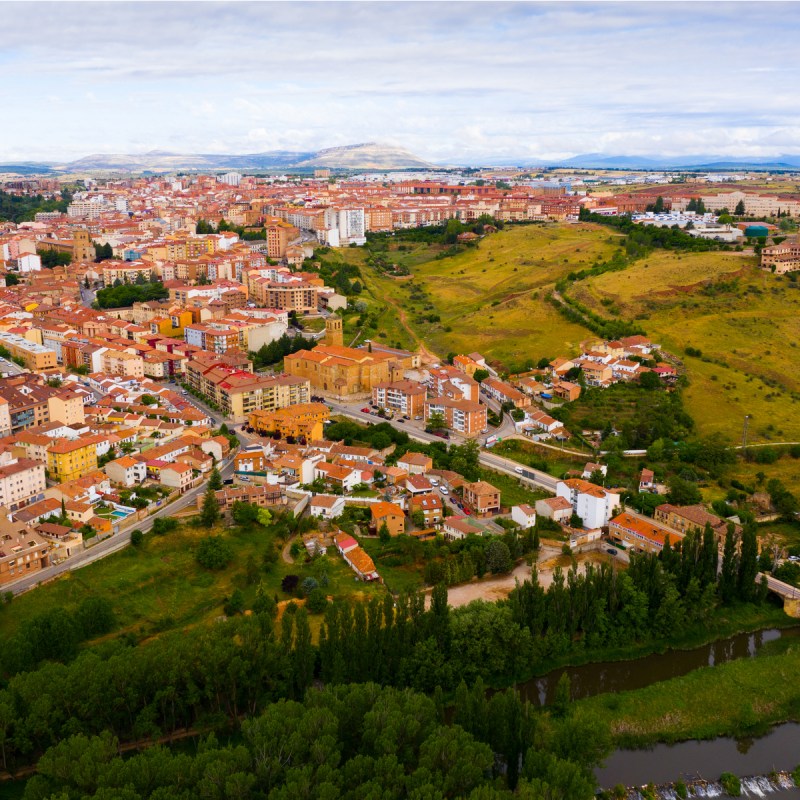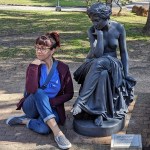
I had the good sense to marry a Spaniard. It’s something I highly recommend, especially if you enjoy great food and wine, raucous firework displays, and traveling like a local through the Mediterranean. Not only do I have a cozy place to stay every time I visit Spain, but I also have the opportunity to visit places that get little ink in a typical Spain guidebook. One of these is Soria, about an hour’s drive northwest of Madrid.
Videos by TravelAwaits
Soria is both a province and a city, located in the eastern portion of the autonomous community of Castile and León. Following settlement by Celtiberian tribes, the land was conquered first by Rome and later by the Christian and Muslim kingdoms. In medieval times, the region was a major wool-manufacturing center. As industrialization took hold in Europe, Soria became increasingly rural. Military enrollment and emigration away from the country depopulated the region once more under dictator Francisco Franco.
In contrast to the largely flat, dry plains of central Spain, Soria is an interesting mix of landscapes — from ruddy cliffs and valleys planted with sunflowers to picturesque villages built into hillsides and verdant vineyards clustered along the Duero River. The assortment of sights and activities makes Soria an excellent place to explore the outdoors, then head into town for a glass of Tempranillo and flavorful tapas and pinchos.
While Soria is popular with Madrileños seeking escape from the city, it’s little-known to travelers outside the country. This makes it both easy to love and simple to get around in. Here’s a sampling of the best things to see and do in Soria.

1. City Of Soria
To begin your journey, head for postcard-like medieval streets in the city of Soria. The most famous building is the Santo Domingo Church, which dates to the 12th century. Its facade is considered one of the finest examples of architecture from the Romanesque period.
The Plaza Mayor in Soria is typically Castilian and is surrounded by a variety of photo-worthy buildings, including the modern town hall and the House of the Twelve Lineages, the original governing body of the city. Less than a half-mile away, the Numantino Museum documents the city’s history, with artifacts from the Paleolithic era through the Middle Ages.
Be sure to stop for lunch or dinner — or both — in Soria. Castilian food, which relies heavily on meat, tends toward the unfussy and pastoral. Traditional dishes include torreznos (marinated and fried pork belly), lamb stew, and migas de pastor (sauteed breadcrumbs with chorizo and eggs). While vegetarian restaurants aren’t common in this area, you can still find meatless salads and side dishes at most restaurants.

2. Monastery Of San Juan De Duero
A short walk away, on the outskirts of the city proper, you’ll find this beautiful monastery. Dating to the 13th century, it’s best known for its series of intricately carved arches. Some are from slightly different time periods; all show the Muslim influence on Romanesque architecture. You can amble through the building’s old halls and courtyards or visit the chapel, with its stone floors and vaulted ceilings.
3. Machado Trail
Seville-born poet Antonio Machado came to Soria in 1907 to teach French at a high school. He created some of his finest work here and met the great love of his life, Leonor Izquierdo… who was 24 years his junior. It’s a tale both questionable and tragic, as Leonor contracted tuberculosis and died in 1912, at just 18 years old. Machado left Soria, never to return again.
Today, you can trace the poet’s footsteps via a walking tour that visits places he loved and that provided inspiration for his work. From the school where he taught to his favorite social club, the couple’s home, and paths along the Duero where he took daydreamy rambles, you’ll gain an understanding of why Soria became Machado’s muse. Next to El Espino Church, pay your respects at Leonor’s grave, and view the tree that was the subject of Machado’s famous “To a Dry Elm Tree.”
4. Mushroom Hunting In The Urbión National Forest
This was one of my favorite parts of our trip to Soria, a multigenerational activity that included my husband and me, his parents, his two brothers, and his youngest brother’s girlfriend.
Urbión is a celebrated location for mushroom hunting. So much so that eagle-eyed fungus fans from Eastern Europe, who seem to possess the preternatural ability to spot a mushroom from a dozen yards away, would make special trips to Soria and pluck the forest clean — or so the locals said. Since then, the government has instituted a licensing program. You must apply in advance with your passport and pay a fee of about 25 euros per person to harvest. A few companies take the guesswork out of it by obtaining permits for you.
Although several varieties of mushrooms grow here, we spent our time combing the forest floor for porcinis. In a couple of hours, the seven of us had filled two big baskets with about 4 pounds of the prized fungus.

5. La Lobita
With mushrooms being the theme of our trip, we stopped for a leisurely lunch at La Lobita in neighboring Navaleno. This minimalist-chic, Michelin-starred restaurant isn’t what you would expect in a tiny rural town. It’s helmed by Elena Lucas, a third-generation female chef de cuisine. Her grandmother, Luciana Lobo — the eponymous “Lobita,” or “little wolf” — was the OG. Lucas, a classically trained chef, now presents dishes inspired by her grandmother’s Castilian recipes, but with a lighter hand and more artful presentation.
In honor of my mother-in-law’s birthday, we had an 11-course, mushroom-focused tasting menu. Each was a thrill for the tastebuds, from the mushroom pate topped with tart apple slices to the autumn stew with morels, and the croquette filled with a truffled quail’s egg. Although dessert — all three courses of it, capped off with handmade cubes of dark chocolate rich with the flavor of violet — didn’t contain mushrooms, it was equally unforgettable.

6. Black Lagoon Of Urbión
This lake, which opens like a yawning mouth within the Urbión Mountains, feels hushed and mysterious. At an altitude of 6,500 feet above sea level, it was formed during the Ice Age and is surrounded by granite cliffs and Scots pines. The lagoon is the subject of many legends. Some say it’s infinite, and connected to the sea through a system of underground caves. Others caution that it’s haunted, or that a hungry creature who lives at the bottom makes a meal of everything that falls in.
Although the Black Lagoon of Urbión is the site of a famous swim crossing on the first Sunday in August, I visited in the fall, when the air was cooler, the days shorter, and the crowds nonexistent. Standing at its edge, I could see why Machado immortalized it in his poem “La Tierra de Alvargonzález.”
Pro Tip: The road to the Black Lagoon is narrow and steep, and not for those who are easily unnerved behind the wheel. It’s also closed, often without warning, during inclement weather. Don’t attempt a trip on a heavily rainy or icy day, and sign up for a tour if you prefer not to drive yourself. If you do drive, park at the lot on Paso de la Serrá and walk to the park, a little less than a mile away.

7. Rio Lobos Canyon
Another favorite moment from our trip was the visit to Rio Lobos, a 15-mile gorge that slices through a limestone plateau. The canyon is located inside a 24,000-acre park, a designated special conservation area for birds. You can access the park — for free — from several points. By far the best way to enter is through the lower portion, via SO-920 between San Leonardo de Yagüe and El Burgo de Osma.
The canyon, whose walls rise like sentinels around a sleeping natural kingdom, is one of the most beautiful landscapes I’ve visited in Spain. At the bottom lies the Chapel of Saint Bartholomew, built in the 1200s in a transitional style between Romanesque and Gothic. It’s a quick visit, and close to several walking trails that take you all around the park.
The trails are easy, although a few contain water crossings where we had to carefully pick our way across. It’s worth it to experience the sheer variety of scenery, including grassy hills, crystalline streams, sloping forests, and cliff faces and caves that provide refuge for bats, European robins, and griffon vultures.

8. El Burgo De Osma
At one end of the Ucero River, you’ll find this former military stronghold. Small, convivial, and lively, its unique charisma comes from a collision of Roman, Arabic, Gothic, and modern influences.
In addition to a compact downtown shopping and dining district, the town boasts a variety of sights. There’s a perfectly preserved Roman bridge, a superb circa-1230 cathedral, Arabic watchtowers, and a porticoed Plaza Mayor. Around the town, you can walk the medieval defensive walls and view well-preserved murals of knights and soldiers.
El Burgo de Osma was an afternoon stop on our way back to Madrid, so I didn’t get the flavor of the town at night, nor did I get to experience its more luxurious side. On my next visit, I plan to stay at Castilla Termal, a hotel and thermal spa located in a 16th-century university.
For more ideas and inspiration for traveling in Spain, explore these articles:

